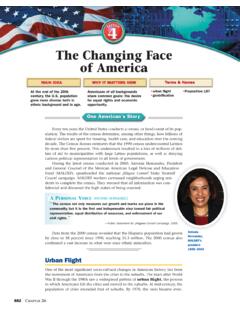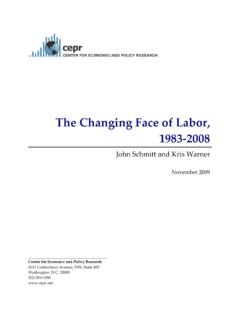Transcription of The Changing Face of Volunteerism
1 The Changing Face of Higher Logic . All rights Andy StegglesBy Andy StegglesPresident & Chief Customer Officer | Higher LogicThe Changing Face of VolunteerismWHITE PAPERThe Changing Face of Higher Logic . All rights Andy StegglesContentExecutive Summary ..3 Types Of Volunteerism ..4 Case Studies ..6 Measuring Engagement ..8 Summary ..11 Special Thanks ..11 Working with ASAE volunteers was a fascinating experience. We found that associations are trying to evolve by becoming more nimble with how they identify and recognize volunteers. The goal is simply to bring advocacy into the traditional volunteer structure, allowing more people to participate and thus build a deeper engagement in our associations. ~ Andy Steggles, President & Chief Customer Officer, Higher Logic2 The Changing Face of Higher Logic.
2 All rights Andy StegglesEXECUTIVE SUMMARYThe ASAE Executive Management Section Council has spent much of the past two years researching what Volunteerism and engagement means to the association community and its governance. The premise behind this is related to the different interpretations of Volunteerism and whether emerging types of engagement should be recognized as Volunteerism and incorporated into the models. The council conducted a survey on volunteer management, as well as more than 50 interviews from different types and sized organizations, to begin to tackle the question of who is a volunteer and how to manage that involvement. Through the research, we reached out to the following groups: Professional societies Trade groups Individual versus corporate memberships Small, medium and large associations and societies Associations with and without components Top down and bottom up driven orgs The conversations highlighted a trend in the association community to seek a better understanding about engaging members, and to recognize new ways in which members can provide value beyond the more traditional, Term-based volunteer opportunities.
3 For the sake of this paper, Term-based volunteer opportunities are defined as the more traditional groups such as committees, boards, chapter officers and other volunteer opportunities requiring a relatively longterm commitment (usually a year or more). This paper details some of the challenges with Term-based Volunteerism , and how some associations are embracing a hybrid approach to incorporate alternative engagement opportunities for their membership, thus allowing a much broader audience and greater level of engagement, satisfaction and ultimately, an improved retention rate. Why Are Associations Trying to Adapt?There have been numerous studies which have demonstrated a strong correlation between member engagement and retention ( Decision to Join by ASAE), yet members have even more limited time to engage.
4 This challenge is compounded by the continuous challenge of disruptive innovation, which allows relatively new companies to compete and potentially displace a more traditional association. There are many organizations encroaching on different core elements of what an association does, such as events, online networks or publishing companies. A simple example many may be familiar with is LinkedIn. It has expanded from being a job-centric company into more robust communities, directories and publishing. How long until LinkedIn adds journals or other educational offerings to its platform? Or conversely, removes a feature users may be dependant on, such as the event calendar that was dropped a couple years organizations have embraced LinkedIn and are trying to leverage it as a strategic advantage.
5 A common way to do this is to leverage LinkedIn as a recruiting tool for members, while at the same time positioning their LinkedIn presence as a billboard to push people towards the association website. Simultaneously, some organizations are trying to become more member-centric by engaging their members in new ways, hence the new attention being given to alternative types of Changing Face of Higher Logic . All rights Andy StegglesWhy Now?Technology has disrupted the member engagement continuum and has evolved to become an enabler. For-profit companies are adopting a lean approach, enabling them to test their market and quickly implement new ideas and solutions at a relatively low cost. Conversely, many associations continue to struggle with bureaucracy and tend to be much less nimble, due to their lack of inclusivity and often inefficient governance structure.
6 Many organizations are witnessing declining retention rates, which could be attributed to many things but usually comes down to providing a dwindling, less relevant value proposition. This assumption is enforced by MGI s recent Membership and Marketing Benchmarking Report, where lack of engagement has been identified as a key driver for an effort to become more member-centric while differentiating themselves from their competition, associations are looking for alternative solutions to provide relevance. Primary ways to do this are embracing different types of Volunteerism , becoming more inclusive, improving member satisfaction and ultimately building a greater sense of you need additional reasons, ASAE s latest research report, 10 Lessons for Cultivating Member Commitment, shares an astonishing fact: one simple volunteer role shifted a member s value perception 6 points (from 38 to 44 percent in the Net Promoter Score).
7 A deeper commitment such as taskforce/committee or longterm volunteer roles, sets the value perception at 60 percent. Authors James Dalton and Monica Dignam made this statement: The visceral experience of involvement is what solidifies their appreciation for what an association is: peers helping peers. TYPES OF VOLUNTEERISMTo recognize the volunteer and engagement opportunities available to your members, it s important to understand the different types of Volunteerism . The following lists three broad areas: Term, Task and Micro. Term VolunteersTerm-based Volunteerism is what most associations currently embrace. These are typically standing committees with 1+ year terms, which require a high level of commitment by their respective members. Other examples include the Board of Directors or House of Delegates.
8 Term-based Volunteerism may also flow through to the component level, such as a Chapter with chapter officers, typically also serving for 1+ year appointments. Task VolunteersTask-based Volunteerism is the opportunity for members to volunteer for a project that is typically a short term role, focused on a specific outcome. These opportunities are often more closely aligned with a member s skill set, thus reducing orientation and training required to make the task even more accessible and happens when an association needs members to collaborate on a whitepaper, select judges for an award or perhaps just write an article for their newsletter? In the past, all of these opportunity types would typically be fulfilled by staff or handed over to a committee.
9 These and other tasks could be a perfect fit for members to opportunities allow members to pick and choose where they think they can provide the most value. In the past, it may have been just the minority of members who were in a personal or professional position to commit to a more traditional, Term-based role. Using that Term-based volunteer model, organizations would be excluding a huge pool of talent who arguably may be more qualified to fulfill a specific task over a shorter period of time. 4 The Changing Face of Higher Logic . All rights Andy StegglesThis approach to Volunteerism has proven to be a win-win in terms of reducing the occasionally overwhelming time demands of its volunteers, as well as embracing a much wider audience of new volunteers to perform much more defined tasks.
10 Staff are now able to utilize members for tasks that a more traditional volunteer group may not have had the bandwidth to undertake within the timeframe required. When creating Task-based volunteer opportunities, it s important to set realistic expectations about the opportunity, such as the estimated time commitment, travel requirements, deadlines and other relevant information. Micro VolunteersWhat about the more dynamic and unstructured volunteer opportunities that occur all the time and are rarely counted as volunteering? The nonprofit sector first identified Micro-volunteering and pushed to embrace it, because like the small financial gifts which add up, the small gift of time spent has the same impact if pooled. The explosion of micro-jobs created an expectation for our members to seek out the same.










